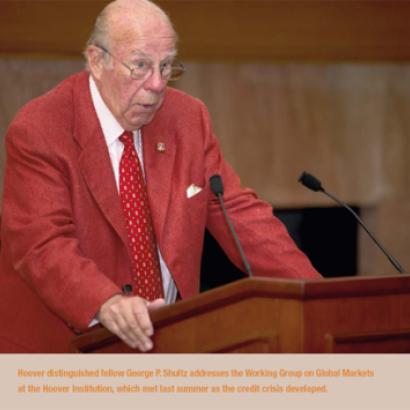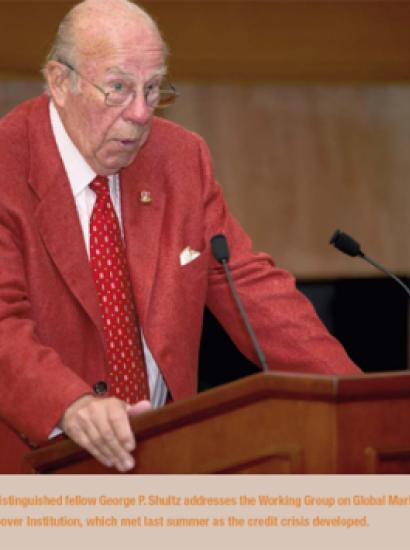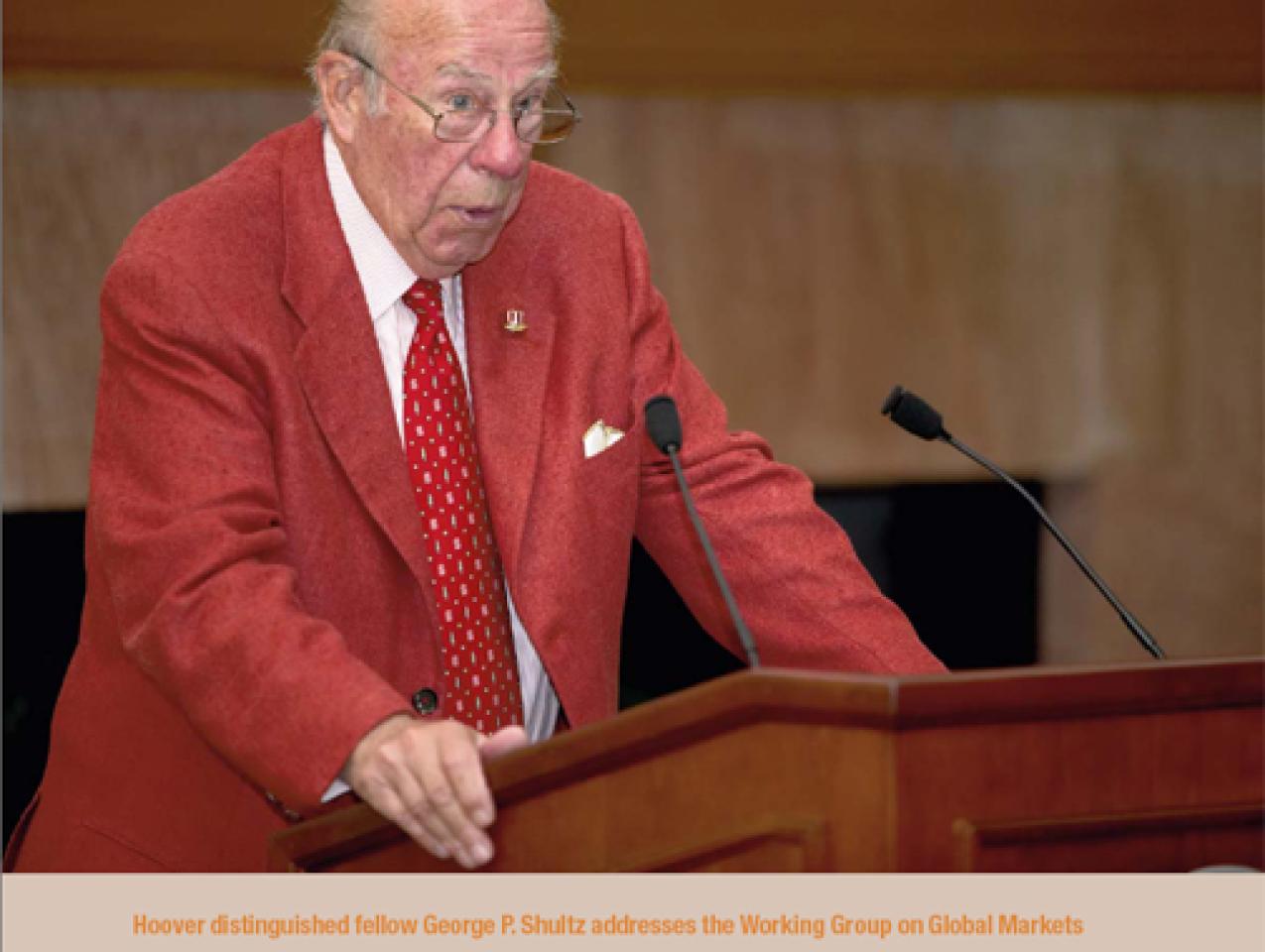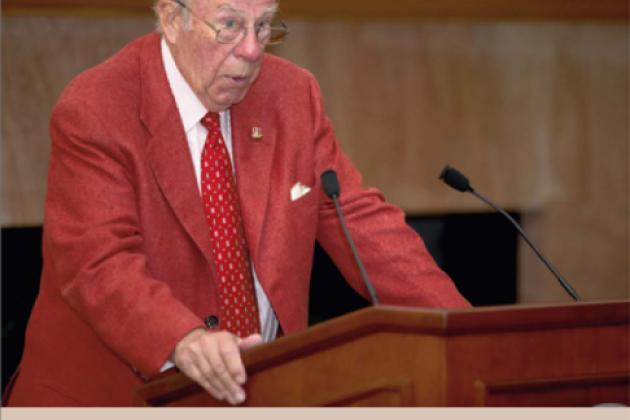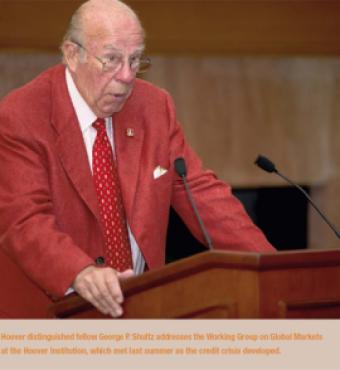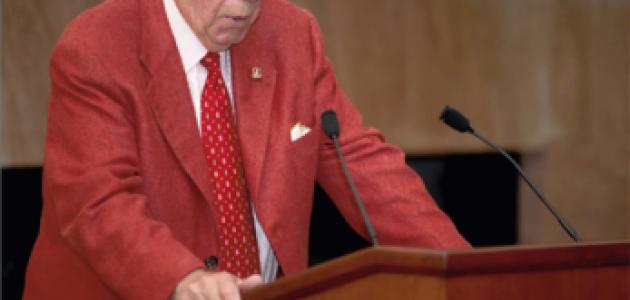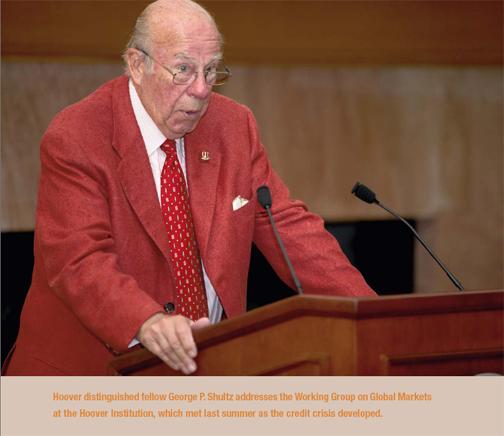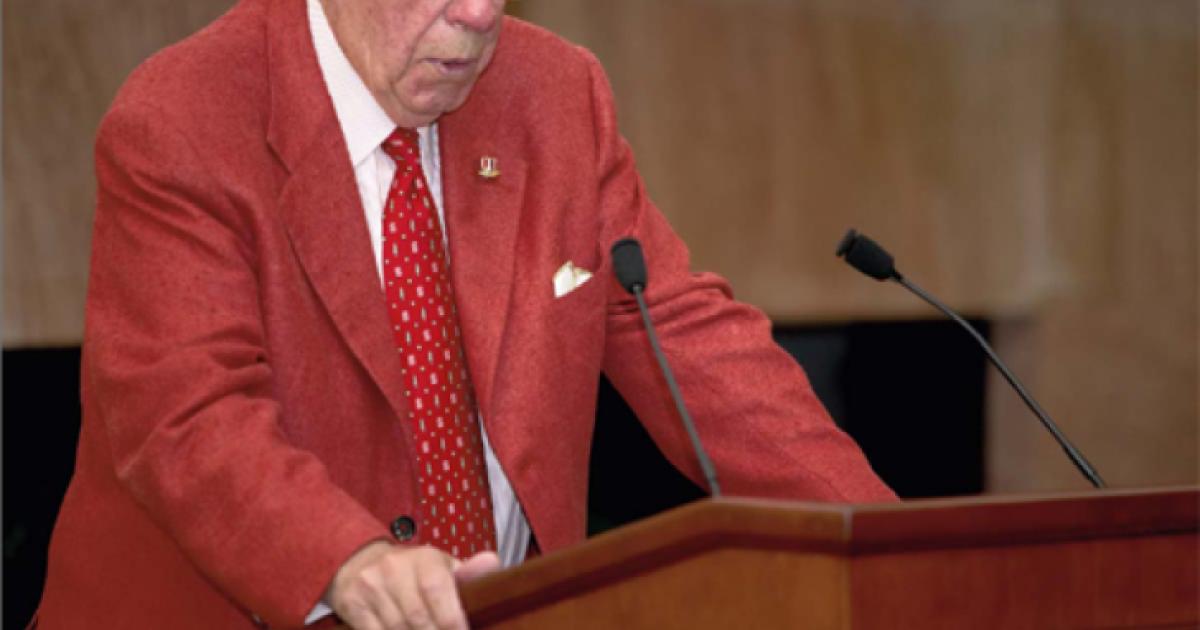- Economics
- US Labor Market
- Budget & Spending
- Monetary Policy
- Law & Policy
- Regulation & Property Rights
- History
- Economic
I like the old saying “An ounce of prevention is worth a pound of cure.” These days, I think it should be quite a few pounds of cure. Prevention can take many forms. Among the most important is learning how to prevent the need for crisis-driven intervention in financial markets by the government. That is partly an issue involving financial institutions and the way they work, partly one addressing the markets themselves, and partly one of developing procedures and guidelines for the appropriate actions of government policy makers in the future. To address these issues, let me begin with how I view the reasons for the current turmoil and my initial reflections on the implications of what has been done.
The effort to identify the sources of the problem can easily lead us into staggering complexity, but there is also a simplicity to it.
People and institutions behave more responsibly when they have some of their own equity at stake. The current financial crisis emerged in such a way that this principle became virtually inoperative. In an effort to make housing more affordable, financial wizards, with the implicit backing of the federal government, figured out how to give houses away: no down payments and few, if any, questions asked about ability to service loans. When you give something away, demand rises rapidly, as do prices, so rapidly rising prices made the easy terms look reasonable and seemed to validate them.
Meanwhile, financial intermediaries packaged these mortgages and traded in them, in all too many cases with very high (30 or so to 1) leverage: once again, little equity in these deals.
All this separated the originator of the mortgage (that is, the risk) from the eventual holder and, at the same time, created obscure financial instruments. So people had little equity in the game but made lots of money, even while not knowing exactly what they were doing. What a party! As Charles Prince, then head of Citicorp, said, “As long as the music is playing, you’ve got to get up and dance.”
In the meantime, I am driven to say, a massive regulatory failure occurred. Apparently, the regulators couldn’t understand these instruments, either, but they didn’t insist. I’m reminded of the great pitcher Walter “Big Train” Johnson. Hitters, when asked how Johnson made them strike out so often, would say, “You can’t hit what you can’t see.” But the regulator is not in the position of the hitter. The regulator can say, “I want you to show me all your pitches and tell me what you’re going to throw before you throw it.”
All this took place in a prolonged period of Fed-provided, exceptionally easy money.
The federal government has acted massively and in many cases in an unprecedented fashion to deal with the financial crisis that has ensued. It has responded to the human problems and social costs of foreclosures, the threat that turmoil in the field of finance will spill over into the rest of the economy, and the emerging lack of confidence among the general public in the wisdom and integrity of many people entrusted with the management of huge sums of money.
Everyone talks about moral hazard, and properly so. I don’t want to second- guess what the authorities have done. If I had been there, I might well have done the same things; the pressures are immense and the stakes are very high. Nevertheless, we now confront the necessity of damping down sharply the expectation that the answer to every problem is government intervention.
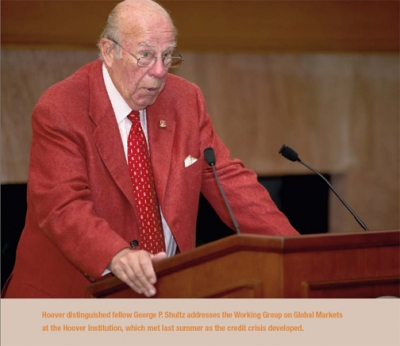
What to do? How to conduct ourselves so that financial institutions operate with a lot of capital at stake and are accountable for their actions? And how do we create financial markets that have the resilience to withstand shocks, as has been true on many occasions in the past?
Perhaps the wheels are starting to turn. The Fed’s stiffening the rules about the conditions of mortgage lending seems to be on the way. More equity will be required. The Federal Reserve needs to re-examine Chairman William McChesney Martin’s famous injunction that the job of the Federal Reserve is “to take away the punch just as the party gets going.” The problem is that the punch bowl has been spiked, so you can’t just simply take it away. Moreover, the job has become more complicated because of unprecedented steps that have been taken.
Long ago, I faced a somewhat similar problem, as I think of it, in the labor field. The Kennedy and Johnson administrations had intervened frequently in major labor disputes, with the final settlement often being made in the White House. I had argued and written, as a University of Chicago professor, that this process was undermining the spirit of free collective bargaining because the parties were not working out their own deals. All this amounted to a labor-relations version of what we now call moral hazard.
When I came into office as labor secretary in 1969, a major strike of longshoremen all along the East and Gulf coasts had been the center of attention for months. President Johnson had intervened, invoking the Taft- Hartley law, which allowed him to seek and get an injunction to stop the strike for eighty days. He did so after finding and declaring the strike a “national emergency.” The unions contested this finding, and the issue went on a fast track to the Supreme Court, which upheld the president. By the time I took office in January 1969, the Taft-Hartley time period had run out and the strike had begun again. All the statutory measures available to deal with it had been used. So I had a stubborn strike on my hands that had been authoritatively declared a national emergency.
I went to President Nixon. “I have a strategy for how to handle this strike,” I told him. “Your predecessor was wrong and the Supreme Court was wrong. This strike will not create a national emergency.” I argued to Nixon that the economy was resilient and that although disruptions could be expected, buyers and sellers had all sorts of ways of finding substitutes for scarce goods: “There will be no dire emergency, and in the end the pressures will work to bring about a private settlement.”
I argued that if we avoided direct intervention, we would deliver a forceful message signaling the administration’s commitment to the free collective bargaining system. We would also teach labor and management an important lesson about allowing private economic processes to work. The president supported me in this strategy, withstanding tremendous pressure on the White House to intervene.
Meanwhile, pressure continued on labor and management. Finally, lo and behold, after about six weeks and some good mediation, labor and management got together and settled the strike. The longshoremen went back to work. By allowing the pressures inherent in the market to have their effect, people were forced to find their own solution. The collective bargaining process was reinvigorated. This approach was a sharp contrast to that taken in the Kennedy-Johnson period, when high-level intervention and jawboning in major disputes were routine, with the result a predictable flow of cases right into the White House. As I said to Nixon: “If the president hangs out his shingle, he’ll get all the business.”
I had a somewhat parallel experience not long after becoming director of the Office of Management and Budget in 1970. I learned that the Penn Central Railroad had badly mismanaged its affairs and was on the verge of bankruptcy. My friend and esteemed colleague Arthur Burns, as chairman of the Fed, was deeply concerned about the potential impact on financial markets and had somehow arranged through a reluctant deputy defense secretary David Packard a large bailout, courtesy of the Pentagon. I found myself arguing in front of the president against this action on the grounds that it would set a terrible precedent and that financial markets were basically strong. (Who was I, a simple labor economist, to argue with Arthur Burns about financial markets?) At a critical moment, in walked Bryce Harlowe, the most savvy congressional and political adviser ever. He said, “Mr. President, in its infinite wisdom, the Penn Central has just hired your old law firm to represent it in this matter. Under these circumstances, you can’t touch this with a ten-foot pole.” So Penn Central went bankrupt. No dominoes fell. The financial system was strengthened by the realization that mismanaged institutions were on their own.
We have all observed a similar experience in the uneasy and sometimes tumultuous international financial markets: the bailouts, starting in Mexico, going through many Asian countries, and, for a while, Russia. But the bailout for Russia was suddenly switched off in 1998, surprising many in the markets. I had long been out of office, but an irate chief executive of a leading bank berated me: “When you bailed out your neighbor Mexico and all these other countries, I was entitled to think that you would bail out Russia, with all its nuclear arms.”
The Russian episode gave the system a jolt, but the system was still unstable. How to bring the problem under control and push the idea of bailouts into the background? Along came the idea, advanced by John B. Taylor, then undersecretary of the Treasury, for a new type of sovereign bond—one with “collective action clauses”—for emerging-market countries. With these new bonds, the countries and the international financial system would be less susceptible to default, thereby reducing the need for bailouts by the International Monetary Fund. People said countries would not sign up, but they did. The effect has been calming.
That is an ounce of prevention that is worth tons of cure. That’s the kind of action we need to look for now. Remember, what you don’t do is often more telling than what you do.








